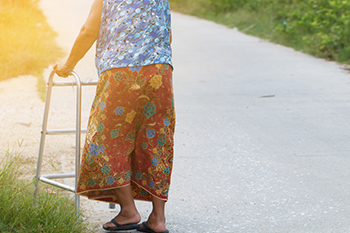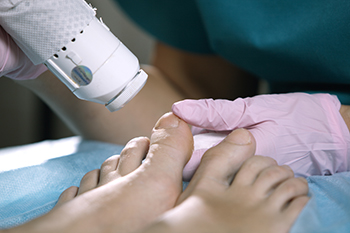Connect With Us
Blog
Items filtered by date: February 2022
How Walking Can Affect Falls in Older People
Hardly anyone thinks about how to walk. After all, we’ve been doing it for years. However, it turns out that ankle flexion, which is one of the components of each step you take, can decrease with age. This loss means taking a shorter stride, landing with flat feet, and putting more space between the feet as you walk. The result is a side-to-side motion that could affect your balance and put you at risk of falling. And rather than transferring the weight from one foot to the other with each step, you end up performing more of a shuffle. This also forces you to look down as you walk, putting your body out of alignment and increasing the risk. An easy solution is to exercise your ankles as often as possible, while watching TV or anytime you are resting. Just push your ankle up and down several times on each foot. Another exercise is the heel press, which stretches the calf muscles and improves flexion of the ankles. Before undertaking any new exercise regime, it is a good idea to seek the advice of a podiatrist who can measure your ankle flexion and monitor your activity.
Preventing falls among the elderly is very important. If you are older and have fallen or fear that you are prone to falling, consult with one of our podiatrists from Foot and Ankle Center. Our doctors will assess your condition and provide you with quality advice and care.
Every 11 seconds, an elderly American is being treated in an emergency room for a fall related injury. Falls are the leading cause of head and hip injuries for those 65 and older. Due to decreases in strength, balance, senses, and lack of awareness, elderly persons are very susceptible to falling. Thankfully, there are a number of things older persons can do to prevent falls.
How to Prevent Falls
Some effective methods that older persons can do to prevent falls include:
- Enrolling in strength and balance exercise program to increase balance and strength
- Periodically having your sight and hearing checked
- Discuss any medications you have with a doctor to see if it increases the risk of falling
- Clearing the house of falling hazards and installing devices like grab bars and railings
- Utilizing a walker or cane
- Wearing shoes that provide good support and cushioning
- Talking to family members about falling and increasing awareness
Falling can be a traumatic and embarrassing experience for elderly persons; this can make them less willing to leave the house, and less willing to talk to someone about their fears of falling. Doing such things, however, will increase the likelihood of tripping or losing one’s balance. Knowing the causes of falling and how to prevent them is the best way to mitigate the risk of serious injury.
If you have any questions, please feel free to contact our office located in Egg Harbor Township, NJ . We offer the newest diagnostic and treatment technologies for all your foot care needs.
Let the Expert Treat Your Ingrown Toenails
Smelly Feet? Blame Bacteria!
Nothing is more embarrassing than having to take off your shoes in public if you have bromodosis, which is the medical term for smelly feet. What causes bromodosis? Bacteria releasing a foul odor as it metabolizes sweat that has accumulated on your skin. Proper hygiene and foot care can usually help you keep bromodosis at bay. Be sure to wash and dry your feet at least once daily. Try antifungal or antibacterial soap. Dry thoroughly between toes and remove any hardened dead skin which are places where bacteria can thrive. Keep your toenails clean and trimmed. Be sure to put on a fresh pair of socks at least once a day, and possibly more if you exercise or live in a hot climate. Moisture-wicking socks that draw moisture away from your skin are best. Shoes should not fit tightly. They should also be switched out every day so they can dry out to prevent bacteria from growing in them. You can also try antifungal foot spray, medicated foot powder, or even foot soaks. Contact your podiatrist if these measures do not get rid of your bromodosis, or if you believe you may have excessively sweaty feet, medically referred to as hyperhydrosis.
Everyday foot care is very important to prevent infection and other foot ailments. If you need your feet checked, contact one of our podiatrists from Foot and Ankle Center. Our doctors can provide the care you need to keep you pain-free and on your feet.
Everyday Foot Care
Often, people take care of their bodies, face and hair more so than they do for their feet. But the feet are a very important aspect of our bodies, and one that we should pay more attention to. Without our feet, we would not be able to perform most daily tasks.
It is best to check your feet regularly to make sure there are no new bruises or cuts that you may not have noticed before. For dry feet, moisturizer can easily be a remedy and can be applied as often as necessary to the affected areas. Wearing shoes that fit well can also help you maintain good foot health, as well as making it easier to walk and do daily activities without the stress or pain of ill-fitting shoes, high heels, or even flip flops. Wearing clean socks with closed shoes is important to ensure that sweat and bacteria do not accumulate within the shoe. Clean socks help to prevent Athlete’s foot, fungi problems, bad odors, and can absorb sweat.
If you have any questions please feel free to contact our office located in Egg Harbor Township, NJ . We offer the newest diagnostic and treatment technologies for all your foot and ankle needs.
How Ankle Sprains Occur
 Ankle sprains result when the ligaments, which connect the bones to each other, get overstretched or torn. Common signs of an ankle sprain include a “snap” or “crack” sound at the moment of injury. Sprains can also lead to bruising, swelling, and difficulty bearing weight. Ankle sprains usually result from the ankle getting twisted or rolled, and are one of the most common injuries that athletes deal with. Sports like soccer, football, and basketball that require a variety of quick movements leave players at a higher risk for ankle sprains. Athletes who have previously sprained an ankle are at a greater risk of re-spraining it. Patients who believe that they have sprained their ankle may wish to consult with a podiatrist for a proper diagnosis, because the symptoms of an ankle sprain and a fracture can be similar.
Ankle sprains result when the ligaments, which connect the bones to each other, get overstretched or torn. Common signs of an ankle sprain include a “snap” or “crack” sound at the moment of injury. Sprains can also lead to bruising, swelling, and difficulty bearing weight. Ankle sprains usually result from the ankle getting twisted or rolled, and are one of the most common injuries that athletes deal with. Sports like soccer, football, and basketball that require a variety of quick movements leave players at a higher risk for ankle sprains. Athletes who have previously sprained an ankle are at a greater risk of re-spraining it. Patients who believe that they have sprained their ankle may wish to consult with a podiatrist for a proper diagnosis, because the symptoms of an ankle sprain and a fracture can be similar.
Although ankle sprains are common, they aren’t always minor injuries. If you need your ankle injury looked at, contact one of our podiatrists from Foot and Ankle Center. Our doctors can provide the care you need to keep you pain-free and on your feet.
How Does an Ankle Sprain Occur?
Ankle sprains are the result of a tear in the ligaments within the ankle. These injuries may happen when you make a rapid shifting movement while your foot is planted. A less common way to sprain your ankle is when your ankle rolls inward while your foot turns outward.
What Are the Symptoms?
- Pain at the sight of the tear
- Bruising/Swelling
- Ankle area is tender to touch
- In severe cases, may hear/feel something tear
- Skin discoloration
Preventing a Sprain
- Wearing appropriate shoes for the occasion
- Stretching before exercises and sports
- Knowing your limits
Treatment of a Sprain
In many cases, the RICE method (Rest, Ice, Compression, and Elevate) is used to treat ankle sprains. However, you should see a podiatrist to see which treatment option would work best with your injury. In severe cases, surgery may be required.
It is important to ask your doctor about rehab options after you receive treatment for your injury. Stretching, strength training, and balance exercises may help the ankle heal while also preventing further injury.
If you have any questions, please feel free to contact our office located in Egg Harbor Township, NJ . We offer the newest diagnostic and treatment technologies for all your foot care needs.
Laser Therapy Treatment for Toenail Fungus
Onychomycosis is a fungal infection of the nail typically characterized by a thickening and discoloration of the nail, a separation of the nail from its bed, pain, and even permanent damage to the nail in severe cases. Because onychomycosis can be difficult to cure and is prone to reoccur, home remedies are typically ineffective, as are many topical and oral antifungal medications. Laser therapy treatments to eradicate toenail fungus have proved to be successful in many patients. This technology utilizes pulses of energy to create precisely targeted heat that kills the fungus living in the nail bed (under the toenail) and prevents it from growing back. The FDA has approved several types of laser devices for the treatment of onychomycosis. If you have a toenail fungus, it is suggested that you make an appointment with a podiatrist to see if you might be a good candidate for Laser therapy treatment.
Laser treatment can be an effective way to get rid of toenail fungus. If you have any questions about laser treatment, consult with one of our podiatrists from Foot and Ankle Center. Our doctors will assess your condition and provide you with quality treatment for fungal nails.
What Are Toenail Fungal Infections?
Onychomycosis, or fungal infection of the nail, is a relatively common and non-serious condition. Around 10 percent of U.S. citizens are afflicted with fungal nails. Common forms of fungus that infect the nail include dermatophytes, yeasts, and molds.
Symptoms of Toenail Fungal Infections Include:
- Nail thickening
- Brittleness of the nail
- Discoloration of the nail
Diagnosis for Fungal Nails
Fungal infections are diagnosed by fungal culture and microscopy. This will rule out any other conditions such as nail trauma, psoriasis, lichen planus, and onychogryphosis.
What Is Laser Treatment?
Laser treatment is a non-invasive, safe, quick, and painless procedure that uses the heat from a laser to kill fungus in the nail. Each infected nail is targeted with a laser for several minutes. The treatment is usually utilized several different times over a select period. During this time, a podiatrist will keep an eye on the infection.
If you have any questions, please feel free to contact our office located in Egg Harbor Township, NJ . We offer the newest diagnostic and treatment technologies for all your foot care needs.




